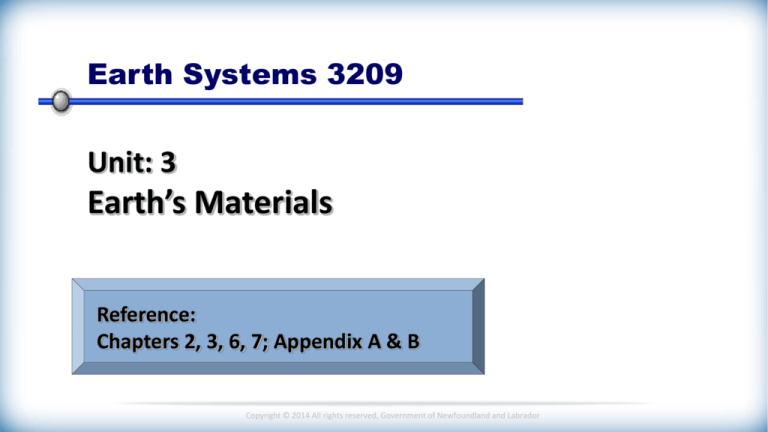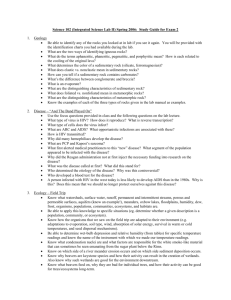
Earth Systems 3209
Unit: 3
Earth’s Materials
Reference:
Chapters 2, 3, 6, 7; Appendix A & B
Copyright © 2014 All rights reserved, Government of Newfoundland and Labrador
Unit 3:
Topic 4.2
Classification of Sedimentary Rocks - Overview
Focus on . . .
identifying and providing an overview of the three
classifications of sedimentary rocks.
Copyright © 2014 All rights reserved, Government of Newfoundland and Labrador
Classification of Sedimentary Rocks
Copyright © 2014 All rights reserved, Government of Newfoundland and Labrador
Classification of Sedimentary Rocks
Sedimentary rocks usually originate in water
environments, either oceans, lakes, or rivers.
Sedimentary rocks are grouped as:
1) Clastic/Detrital
2) Chemical
3) Biochemical
Text Reference:
pages 159-173
Clastic and Chemical are the most common
sedimentary rocks. They make up the majority
of sedimentary rocks found on Earth’s surface.
Copyright © 2014 All rights reserved, Government of Newfoundland and Labrador
Three Classes of Sedimentary Rocks
1) Clastic/Detrital sedimentary rocks
Form when weathered materials called sediment, is
transported, deposited and lithified by compaction
and cementing to form solid rock.
2) Chemical sedimentary rocks
Form when soluble materials get dissolved and
transported to water environments where it then
precipitates/evaporates to form solid rock.
3) Biochemical sedimentary rocks
Form as a result of once living organisms
accumulating to form solid rock.
Copyright © 2014 All rights reserved, Government of Newfoundland and Labrador
1) Clastic Sedimentary Rocks
Consist of solid particles from weathered rocks.
These rock fragments include pebbles, sand,
silt and clay.
Rock fragments are a result of physical
weathering.
These rocks usually form in water environments
such as, rivers, lakes, oceans, but can also
form in deserts.
Copyright © 2014 All rights reserved, Government of Newfoundland and Labrador
1) Clastic Sedimentary Rocks
Geologist use particle size to distinguish
between clastic sedimentary rocks, as seen
in the table below.
Particle Name
Boulders/
Pebbles
Sand
Silt
Clay
Sediment Name
Round
Gravel
Angular
Sand
Mud
Mud
Rock Name
Conglomerate
Breccia
Sandstone
Siltstone
Shale
Copyright © 2014 All rights reserved, Government of Newfoundland and Labrador
Sediment – Particle Size
This figure shows
how clastic
sediment of various
sizes will, after
compaction and
cementation, form
different types of
clastic/detrital
sedimentary rocks.
The process of
sediment turning
into rock is called
lithification.
Copyright © 2014 All rights reserved, Government of Newfoundland and Labrador
2) Chemical Sedimentary Rocks
These rocks form as a result of chemical weathering dissolving
chemicals and transporting it in solution. When conditions are
right, these dissolved chemicals change back into a solid
through the processes of precipitation and evaporation.
Precipitation:
Process where chemicals dissolved on solution, fall
out of solution and forms a solid material. Most
common in shallow water environments.
Evaporation:
Process where there is a change in state from a
liquid to a gas. Chemicals dissolved in the liquid
(water) are left behind as a solid material.
Copyright © 2014 All rights reserved, Government of Newfoundland and Labrador
2) Chemical Sedimentary Rocks
These rocks usually form in water environments such as
lakes and shallow seas or oceans.
Some examples of chemical sedimentary rocks include;
1) Limestone (Calcite) - (form by precipitation)
2) Rock Gypsum - (form by precipitation and evaporation)
3) Rock salt (Halite) – (from by evaporation)
Note: Evaporation and Precipitation often work together. As water
evaporates, chemicals in solution will precipitate.
Example: Rock Salt (Halite).
Copyright © 2014 All rights reserved, Government of Newfoundland and Labrador
3) Biochemical Sedimentary Rocks
Precipitation may occur as a result of physical
processes, or indirectly through life processes of
water-dwelling organisms. Sedimentary rocks
formed in this way are referred to as Biochemical.
Many organisms excrete dissolved
minerals to form shells and when they
die the shells accumulate on the sea
floor and form a rock called Coquina.
Copyright © 2014 All rights reserved, Government of Newfoundland and Labrador
3) Biochemical Sedimentary Rocks
Biochemical
Sedimentary rock created when organisms use
materials dissolved in air or water to build their tissue.
Examples include:
• Coquina
• Chaulk
• Chert
• Limestone (Coral)
• Coal
Copyright © 2014 All rights reserved, Government of Newfoundland and Labrador
3) Biochemical Sedimentary Rocks
Biochemical
Sedimentary rock created when organisms
use materials dissolved in air or water to
build their tissue.
A common organic biochemical rock is coal,
which forms when plant material in water
saturated environments (swamps) die and
accumulate to form peat. As peat is buried it
compresses and eventually changes to form
coal.
Copyright © 2014 All rights reserved, Government of Newfoundland and Labrador
Example 1:
Which agent of erosion shaped the particles that
formed the rock in the diagram to the right?
(A) glacial ice
(B) mass movement
(C) running water
(D) wind
Which best describes gravel, sand and clay?
(A) cements
(B) organic remains
(C) chemical precipitates
(D) sediments
Copyright © 2014 All rights reserved, Government of Newfoundland and Labrador
Example 2:
Which table below correctly
classifies the rocks?
A
B
C
D
Classification
Clastic
Biochemical
evaporite
Rocks
A, B, C, D
E
F
Classification
Clastic
Biochemical
evaporite
Rocks
A, B, C
D
E, F
Classification
Clastic
Biochemical
evaporite
Rocks
A, B, F
E
C, D
Classification
Clastic
Biochemical
evaporite
Rocks
A, C
B, E
D, F
Copyright © 2014 All rights reserved, Government of Newfoundland and Labrador
Your Turn . . .
Take the time and complete the following questions . . .
(Solutions to follow)
Question:
Citing two differences, compare clastic and
chemical sedimentary rocks.
Copyright © 2014 All rights reserved, Government of Newfoundland and Labrador
Solutions . . .
Answer:
Differences are seen because clastic and chemical
sediments are formed by different processes.
1) Clastic sediment forms when pre-existing rocks are
weathered by a physical weathering and are lithified to
form solid rock. Whereas, chemical sediment forms
when chemical weathering dissolves rock material in
solution and precipitates the chemical to form solid rock.
2) Clastic rocks are generally classified by particle size,
whereas, chemical rocks are classified by its chemical
composition.
Copyright © 2014 All rights reserved, Government of Newfoundland and Labrador
Summary . . .
Overview of Points covered:
Sedimentary Rocks can be classified three ways:
1) Clastic or Detrital
-- contain particles
2) Chemical
-- contain chemicals
3) Biochemical
-- contain once living material
Copyright © 2014 All rights reserved, Government of Newfoundland and Labrador









